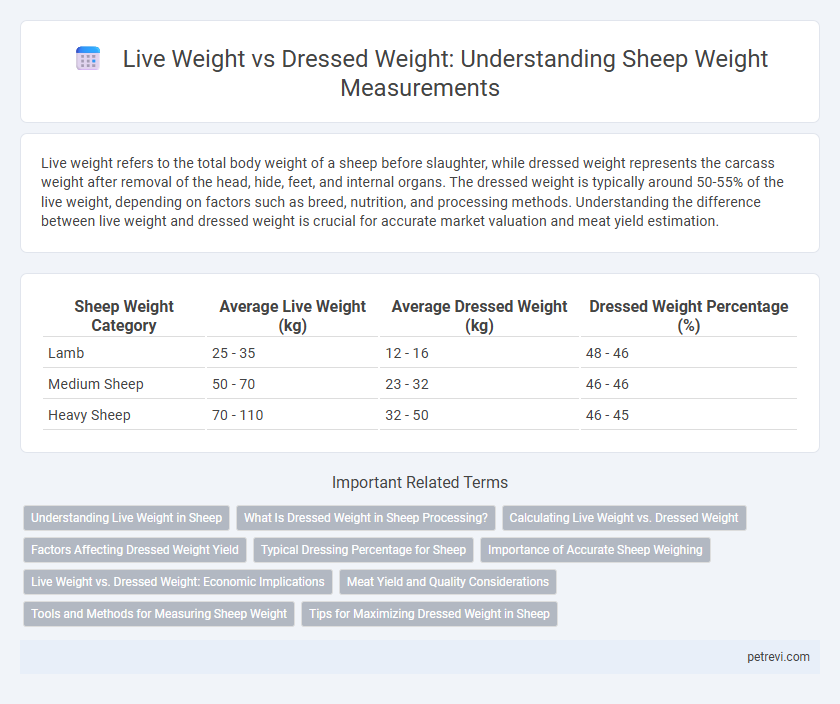Live weight refers to the total body weight of a sheep before slaughter, while dressed weight represents the carcass weight after removal of the head, hide, feet, and internal organs. The dressed weight is typically around 50-55% of the live weight, depending on factors such as breed, nutrition, and processing methods. Understanding the difference between live weight and dressed weight is crucial for accurate market valuation and meat yield estimation.
Table of Comparison
| Sheep Weight Category | Average Live Weight (kg) | Average Dressed Weight (kg) | Dressed Weight Percentage (%) |
|---|---|---|---|
| Lamb | 25 - 35 | 12 - 16 | 48 - 46 |
| Medium Sheep | 50 - 70 | 23 - 32 | 46 - 46 |
| Heavy Sheep | 70 - 110 | 32 - 50 | 46 - 45 |
Understanding Live Weight in Sheep
Live weight in sheep refers to the total weight of the animal while alive and unprocessed, serving as a key indicator for health assessment and market value. It directly influences feeding regimens, growth monitoring, and accurate dosing of medications, providing essential data for effective livestock management. Understanding live weight enables producers to estimate dressed weight, which is the weight after slaughter, helping optimize production and profitability.
What Is Dressed Weight in Sheep Processing?
Dressed weight in sheep processing refers to the carcass weight after the removal of wool, head, feet, and internal organs, typically representing about 50-55% of the live weight. This measurement is crucial for evaluating meat yield and determining market value. Understanding the conversion from live weight to dressed weight helps farmers and processors optimize production efficiency and pricing strategies.
Calculating Live Weight vs. Dressed Weight
Calculating live weight versus dressed weight in sheep is essential for accurate meat yield estimation and market pricing. Live weight is the total body mass of the sheep before slaughter, while dressed weight, or carcass weight, refers to the weight after removing the head, hide, feet, and internal organs. The dressed weight typically ranges between 48% to 55% of the live weight, varying by breed, feed, and processing methods.
Factors Affecting Dressed Weight Yield
Dressed weight yield in sheep is influenced primarily by factors such as breed, age, diet, and sex, with mature rams generally producing higher yields than ewes. Nutrition quality directly impacts muscle development and fat deposition, altering the ratio of live weight to dressed weight. Environmental stressors and slaughter techniques also play significant roles in determining carcass yield and meat quality.
Typical Dressing Percentage for Sheep
The typical dressing percentage for sheep ranges between 50% and 55%, indicating that the dressed weight is approximately half of the live weight. This percentage varies depending on factors such as breed, diet, and fat cover but generally remains consistent within this range. Understanding this ratio is crucial for accurate yield estimation in sheep meat production and processing.
Importance of Accurate Sheep Weighing
Accurate sheep weighing ensures precise determination of live weight and dressed weight, which directly impacts market value and feed management strategies. Live weight reflects the total body mass, while dressed weight indicates the carcass yield after slaughter, typically ranging from 45% to 55% of live weight. Maintaining exact measurements optimizes carcass quality assessment and enhances profitability in sheep production.
Live Weight vs. Dressed Weight: Economic Implications
Live weight refers to the total weight of a sheep before slaughter, while dressed weight indicates the carcass weight after removing the hide, head, hooves, and internal organs. The economic implications hinge on the conversion ratio between live weight and dressed weight, typically ranging from 45% to 55%, which directly affects market pricing and profitability for producers. Optimizing dressing percentage through breed selection and feeding strategies enhances revenue by maximizing meat yield from the live animal.
Meat Yield and Quality Considerations
Live weight in sheep typically exceeds dressed weight by 45-55%, with dressed weight representing the carcass weight after removal of skin, head, feet, and internal organs, crucial for accurate meat yield assessment. Meat quality considerations, such as muscle-to-fat ratio and fat distribution, directly influence the conversion efficiency from live weight to premium cuts, impacting overall economic value. Understanding the relationship between live and dressed weights aids producers in optimizing feeding strategies and ensuring consistent meat quality standards for the market.
Tools and Methods for Measuring Sheep Weight
Accurate measurement of live weight and dressed weight in sheep is essential for effective livestock management and market valuation. Tools such as livestock scales, weigh crates, and digital load cells offer precision in assessing live weight, while carcass weight is determined post-slaughter using calibrated hanging scales or electronic weigh systems. Advanced technologies including RFID-enabled scales and software analytics enhance data accuracy and streamline the weight recording process for farmers and processors.
Tips for Maximizing Dressed Weight in Sheep
Maximizing dressed weight in sheep requires managing live weight through strategic feeding and health care. Providing high-quality pasture or supplemental grain increases muscle mass and fat reserves, directly enhancing carcass yield. Regular parasite control and stress reduction improve overall growth efficiency, thereby maximizing the proportion of live weight converted to dressed weight.
Live Weight vs Dressed Weight for Sheep Weight Infographic

 petrevi.com
petrevi.com